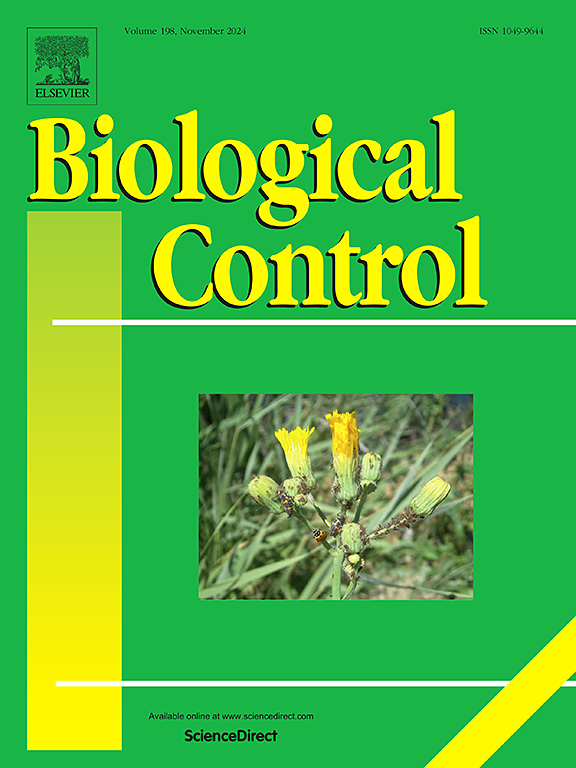大豆驯化与植物-草食性-寄生性相互作用的诱导胁迫
IF 3.4
2区 农林科学
Q2 BIOTECHNOLOGY & APPLIED MICROBIOLOGY
引用次数: 0
摘要
植物驯化和土壤重金属污染改变植物-昆虫相互作用,影响自下而上和自上而下的效应。然而,它们对植物、食草动物和拟寄生物的综合影响尚不清楚。本研究选取了同一地区野生型N23312、地方型N28386和栽培型湘豆33 3种大豆基因型,研究了基因型和铅对大豆、草食性斜纹夜蛾及其寄生蜂斑蛾的综合影响。大豆基因型、Pb及其组合显著影响大豆的营养和防御成分,影响斜纹夜蛾和白斑夜蛾的适合度,并影响拟寄主的选择。铅胁迫降低了大豆可溶性蛋白和糖含量,增加了胰蛋白酶抑制剂和叶片铅含量,延长了斜纹山楂的发育期,同时降低了其存活率和体重。铅胁迫降低了白斑姬茧虫的茧重、成虫寿命、后胫长度和后代繁殖力,延长了寄生蜂的发育周期。铅胁迫对大豆植株防御的影响在不同基因型间差异显著。野生基因型受影响最大,其次是地方基因型和栽培基因型,负向影响斜纹夜蛾和白斑夜蛾。pulchricornis在铅胁迫下对斜纹夜蛾幼虫表现出偏好,偏好程度从野生型到地方型再到栽培型。这一发现增强了我们对驯化和环境胁迫下植物-昆虫相互作用的生态机制的理解。本文章由计算机程序翻译,如有差异,请以英文原文为准。

Soybean domestication and lead stress on plant–herbivore–parasitoid interactions
Plant domestication and soil heavy metal pollution alter plant–insect interactions and influence bottom-up and top-down effects. However, their combined effect on plants, herbivores, and parasitoids remains unclear. Here, we selected three soybean genotypes, namely wild N23312, landrace N28386, and cultivated Xiangdou 33, from the same region and examined the combined effects of soybean genotype and lead (Pb) on soybeans, the herbivore Spodoptera litura, and its parasitoid Meteorus pulchricornis. The effects of soybean genotype, Pb, and their combination significantly affected soybean nutrition and defense compounds, as well as the fitness of S. litura and M. pulchricornis, along with parasitoid host selection. Pb stress decreased soybean soluble protein and sugar contents, increased trypsin inhibitor and leaf Pb contents, and extended the developmental period of S. litura while simultaneously reducing its survival and body weight. Pb stress reduced M. pulchricornis cocoon weight, adult longevity, hind tibial length, and offspring fecundity and extended the parasitoid developmental period. Pb stress primed soybean plant defenses and the effects varied significantly among soybean genotypes. The wild genotype was affected the most, followed by the landrace and cultivated genotypes, which negatively affected S. litura and M. pulchricornis. Meteorus pulchricornis exhibited a preference for S. litura larvae in Pb-stressed soybeans, with preference ranking from wild to landrace to cultivated genotypes. The findings enhance our understanding of the ecological mechanisms underlying plant–insect interactions under domestication and environmental stress.
求助全文
通过发布文献求助,成功后即可免费获取论文全文。
去求助
来源期刊

Biological Control
生物-昆虫学
CiteScore
7.40
自引率
7.10%
发文量
220
审稿时长
63 days
期刊介绍:
Biological control is an environmentally sound and effective means of reducing or mitigating pests and pest effects through the use of natural enemies. The aim of Biological Control is to promote this science and technology through publication of original research articles and reviews of research and theory. The journal devotes a section to reports on biotechnologies dealing with the elucidation and use of genes or gene products for the enhancement of biological control agents.
The journal encompasses biological control of viral, microbial, nematode, insect, mite, weed, and vertebrate pests in agriculture, aquatic, forest, natural resource, stored product, and urban environments. Biological control of arthropod pests of human and domestic animals is also included. Ecological, molecular, and biotechnological approaches to the understanding of biological control are welcome.
 求助内容:
求助内容: 应助结果提醒方式:
应助结果提醒方式:


